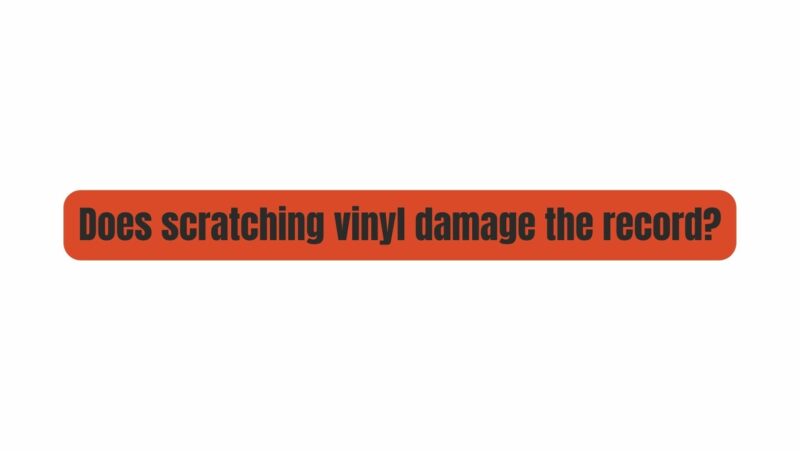Vinyl records, a timeless medium for music playback, have seen a resurgence in popularity in recent years, not only among audiophiles but also among DJs who appreciate their unique sound and tactile experience. One common concern that arises in the world of vinyl records, especially among DJs, is whether scratching vinyl damages the record. In this comprehensive article, we will delve deep into the world of vinyl scratching, debunk myths, and explore the actual impact of DJ techniques on vinyl records.
The Art of Scratching:
Before we address the question of whether scratching damages vinyl records, let’s first understand what scratching entails. Scratching is a DJ technique that involves manipulating a vinyl record on a turntable to produce rhythmic and percussive sounds. It is widely associated with hip-hop and turntablism, where DJs use the turntable’s platter and crossfader to create intricate and expressive patterns. Scratching has become a form of artistic expression, with skilled DJs pushing the boundaries of what can be achieved with vinyl records.
Myths About Scratching and Vinyl Damage:
Over the years, several myths and misconceptions about scratching vinyl records have circulated. Let’s debunk some of these myths before exploring the actual impact:
- Myth: Scratching always damages vinyl records.
- Reality: Scratching does not inherently damage records. The impact on a record depends on various factors, including the quality of the record, the stylus used, and the DJ’s technique.
- Myth: Scratching causes irreparable grooves and ruins the record.
- Reality: While scratching does create new grooves on the record’s surface, these grooves are part of the creative process and can often be smoothed out or mitigated with proper techniques.
- Myth: You need to use old or disposable records for scratching.
- Reality: Many DJs use well-maintained and high-quality records for scratching, as they offer better sound quality and durability.
- Myth: Scratching causes immediate and noticeable audio degradation.
- Reality: When done skillfully, scratching should not result in immediate audio degradation. Skilled DJs maintain the integrity of the record’s audio while manipulating it creatively.
Understanding Vinyl Record Composition:
To assess the impact of scratching on vinyl records, it’s crucial to understand the composition of a vinyl record. A standard vinyl record consists of several layers:
- Vinyl Groove: This is where the audio information is physically encoded. It consists of a spiral groove that spirals inward from the outer edge to the center.
- Vinyl Platter: The vinyl groove is typically pressed onto a circular vinyl platter, providing the record’s rigidity and shape.
- Label: In the center of the record is a label, often containing information about the artist, album, and tracklist.
- Outer Edge: The outer edge of the vinyl record is where the grooves begin and is usually the part that first contacts the turntable’s stylus.
- Inner Groove: Toward the center of the record, the grooves become narrower and closer together. This area contains the last tracks on the album.
Impact of Scratching on Vinyl Records:
Now that we understand the structure of a vinyl record and have debunked some myths, let’s explore the actual impact of scratching on records:
- Groove Wear: Scratching creates additional grooves on the record’s surface. Over time, these grooves can accumulate wear and tear, affecting the record’s overall sound quality. However, this wear is a gradual process and may not be immediately noticeable.
- Stylus and Cartridge: The choice of stylus and cartridge plays a significant role in the impact of scratching. DJs often use specialized needles designed for scratching, which are less likely to cause excessive wear on records compared to traditional hi-fi needles.
- Technique Matters: A skilled DJ can minimize the wear and tear on a record by using proper technique. Techniques like back-cueing and slip-cueing help reduce the friction and stress on the vinyl.
- Maintenance: Regular maintenance of both the record and the equipment is essential. Cleaning records before and after use, along with proper calibration of the turntable, can mitigate damage.
- Record Quality: The quality of the vinyl record itself matters. Higher-quality pressings with thicker vinyl are more durable and can withstand scratching better than thinner or lower-quality records.
Preserving Your Vinyl Records:
To ensure that scratching doesn’t significantly damage your vinyl records, consider the following tips:
- Use Dedicated Scratching Records: Reserve specific records for scratching, especially if you are a DJ. These can be older records or ones you are willing to sacrifice for the art.
- Invest in High-Quality Needles: Use specialized DJ needles and cartridges designed for scratching. These are engineered to reduce wear on records while providing precise control.
- Practice Proper Technique: Spend time honing your scratching technique to minimize wear and tear on the records. Techniques like “baby scratching” involve lighter touches, reducing friction.
- Clean and Maintain Your Records: Regularly clean your records before and after use to prevent dust and debris from causing additional wear. Keep your turntable in good working condition.
- Consider Digital Vinyl Systems (DVS): DVS systems, like Serato or Traktor, allow DJs to use digital files with vinyl control records. This can reduce wear on traditional vinyl records.
Conclusion:
In conclusion, scratching vinyl records does have an impact on their surface, but it does not necessarily equate to immediate and irreversible damage. The extent of wear and tear largely depends on factors such as technique, equipment, and record quality. DJs who employ proper scratching techniques, use dedicated equipment, and maintain their records can enjoy the art form without sacrificing the longevity of their vinyl collection.
Scratching, when executed with skill and care, is a testament to the resilience and versatility of vinyl records as a medium for artistic expression. As vinyl continues to be cherished for its analog warmth and tactile experience, it’s essential to dispel myths and promote responsible practices that allow both DJs and audiophiles to embrace the art of scratching while preserving the legacy of vinyl records for future generations.

